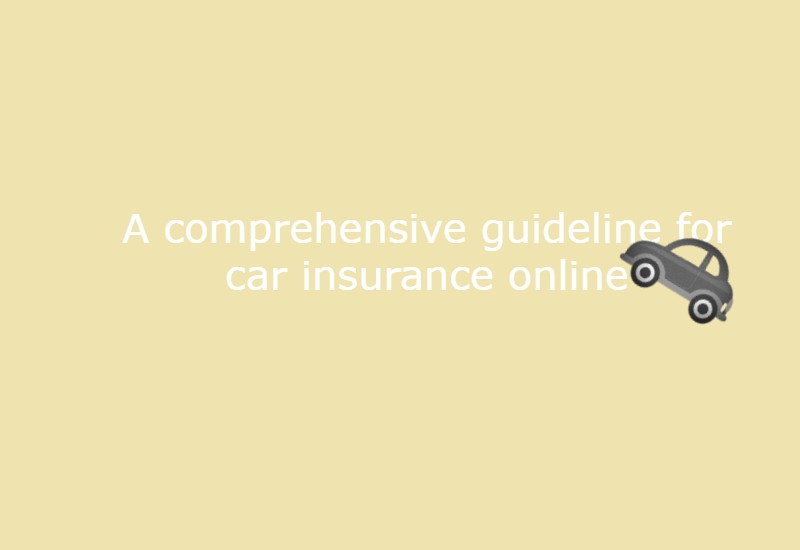
Desk Report
19 July, 2023 02:33
A comprehensive guideline for car insurance online

What does car insurance mean?
Insurance is a type if security that provides financial protection against losses or damages, and car insurance is that types of security which may secured your vehicle for any lose. It is a contract between the policyholder and an insurance company, where the party pay a premium in exchange for coverage.
Here I'm going to discuss about car insurance in this article. Hope you will be helpfull in this regard.
Here are some key points about car insurance:
Coverage
Car insurance typically provides coverage for different types of risks. The specific coverage depending on the insurance policy and the options you choose. Common coverage types are as follows:
a. Liability coverage: This covers costs associated with injuries or property damage to others if you are at fault in an accident.
b. Collision coverage: This covers damage to your vehicle in case of a collision, regardless of fault.
c. Comprehensive coverage: This covers damage to your vehicle caused by non-collision events, such as theft, vandalism, natural disasters, or hitting an animal.
d. Uninsured/underinsured motorist coverage: This provides protection if you are involved in an accident with a driver who doesn't have insurance or has insufficient coverage.
e. Personal injury protection (PIP) or medical payments coverage: This covers medical expenses for you and your passengers in case of injuries sustained in an accident, regardless of fault.
Premium
The premium is the amount you pay to the insurance company for your car insurance coverage. It can be paid in various ways, such as monthly, quarterly, or annually. The premium amount is determined based on several factors, including your driving record, the make and model of your vehicle, your location, your age, and the coverage options you choose.
Deductible
A deductible is the amount you are responsible for paying out of pocket before the insurance coverage kicks in. For example, if you have a $500 deductible and your car sustains $2,000 in damages, you would pay the first $500, and the insurance company would cover the remaining $1,500.
Exclusions
Car insurance policies often have certain exclusions, which are specific circumstances or events that are not covered by the policy. It's important to carefully review the policy terms and conditions to understand these exclusions.
Claims
In the event of an accident or damage, you must file a claim with your insurance company. The claims process typically involves reporting the incident, providing relevant documentation (such as a police report or photographs), and working with the insurance company to assess the damages and process the claim.
Car insurance is mandatory in many jurisdictions to ensure that drivers can cover potential liabilities and protect their own vehicles. It is important to understand the coverage options, policy terms, and conditions before selecting a car insurance policy to ensure you have adequate protection in case of an accident or loss.
Getting car insurance online can be a convenient and efficient way to protect your vehicle.
Here is a comprehensive guideline to help you navigate the process:
Determine coverage you needs
Before searching for car insurance online, assess your coverage requirements. Consider factors like your car's value, your driving habits, and any legal requirements in your jurisdiction. Common coverage types include liability, collision, comprehensive, uninsured/underinsured motorist, and personal injury protection.
Research reputable insurance companies
Look for established and reputable insurance providers. Read customer reviews, check their financial strength ratings, and evaluate their claims process. Compare multiple insurers to find the one that offers the best coverage options and competitive rates.
Collect necessary information
Before applying for car insurance online, collect relevant information such as your driver's license number, vehicle identification number (VIN), vehicle details (make, model, year), driving history, and any existing insurance policy details.
Obtain quotes
Visit insurance company websites or use comparison websites to obtain quotes. Enter your information accurately and provide the requested details to receive accurate quotes. Consider getting quotes from multiple insurers to compare coverage options and prices.
Review coverage options
Carefully review the coverage options provided by each insurer. Ensure they meet your requirements and provide adequate protection for your vehicle. Pay attention to deductibles, limits, and additional features like roadside assistance or rental car coverage.
Understand policy terms and conditions
Read through the policy terms and conditions of the insurance plans you are considering. Pay attention to exclusions, limitations, cancellation policies, and any additional fees or charges.
Assess discounts and benefits
Look for discounts and benefits that can help reduce your premiums. Common discounts include safe driver discounts, multi-policy discounts, good student discounts, and discounts for certain safety features in your vehicle.
Consider customer service and claims process
Research the insurance company's customer service reputation and claims process. Find out if they have a 24/7 claims hotline, online claims submission options, and a straightforward claims process.
Verify the insurer's credentials
Check if the insurance company is licensed in your jurisdiction and verify their credentials. You can usually find this information on the website of your state's insurance regulatory authority.
Apply for insurance
Once you've selected an insurance provider, complete the online application process. Enter your personal information accurately and provide any necessary documentation. Review the application before submitting it to ensure accuracy.
Make payment
After submitting your application, you will be prompted to make a payment. Online insurers usually offer various payment options such as credit/debit cards, bank transfers, or electronic wallets. Choose the option that works best for you.
Review your policy documents
Once your payment is processed, you will receive your policy documents electronically. Review them carefully to ensure that all the information is correct and that the coverage matches what you applied for.
Maintain proof of insurance
Keep a digital or printed copy of your insurance documents readily available in your vehicle. Many jurisdictions require drivers to carry proof of insurance at all times.
Regularly review and update y6our coverage
As your circumstances change, such as buying a new car or moving to a different location, review your coverage and update it if necessary. Regularly compare quotes to ensure you're still getting the best value for your insurance.
In conclusion, car insurance is a critical aspect of responsible vehicle ownership. Taking the time to research, compare quotes, and understand your policy will help you make informed decisions and find the right coverage online.







 জকিগঞ্জে জুয়া খেলায় ৬ যুবকের কারাদন্ড
জকিগঞ্জে জুয়া খেলায় ৬ যুবকের কারাদন্ড 




 IT Lab Solutions Ltd.
IT Lab Solutions Ltd.
আপনার মন্তব্য